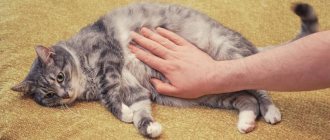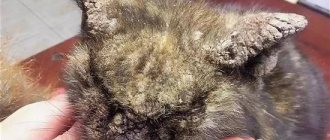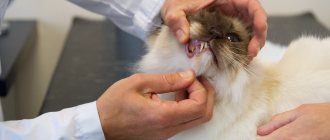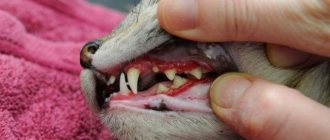The Murkoshi team will tell you how to determine that a cat has toothache, what diseases there are in the oral cavity, and how to help your pet in this situation. It turns out that cats, like people, have many oral diseases: caries, osteomyelitis, periodontitis, gingivitis and much more. You can learn about all this in detail in this article.
1) How to determine that a cat has toothache
2) Causes of dental diseases
3) Why does a kitten’s teeth hurt?
4) Symptoms of diseased teeth
5) Dental treatment
6) Prevention of dental diseases in kittens
How to tell if your cat has toothache
Toothache for cats is not only an unpleasant sensation, but also a risk factor for the occurrence of other, more serious diseases of organs and body systems. Therefore, it is very important to monitor the oral health of your beloved pets.
It is not difficult to identify toothache in an animal. Firstly, a cat with bad teeth eats slowly, carefully and with extreme caution. In addition, the unfortunate animal may accidentally drop pieces of food from its mouth. In this state, the cat is not able to eat much. Secondly, due to severe pain, the cat may refuse to eat at all. Thirdly, if the teeth itch, the kitten may rub its muzzle against chairs or other hard furniture, making plaintive sounds.
Caring for your cat's mouth
Just like ours, cats' mouths need care. Poor dental health can lead to a number of unpleasant diseases and even cause tooth loss.
A cat's mouth is not the cleanest place at the best of times. A lot of bacteria will enter your cat's mouth every day from food, grooming, and anything else they receive during the day. To keep your cat as healthy as possible, you will need to help her a little with her hygiene.
There are many things you can do to help improve your cat's dental health.
Brushing
It may seem like an impossible task, but brushing your cat's teeth can really help them. This is easier if they get used to it as kittens, but older cats can learn to let you do it too. You will need:
- Cat toothpaste. Never use human toothpastes on your pets as they may not spit it out.
- A cat toothbrush, finger brush, or microfiber cloth is intended for cleaning teeth.
You will need to gradually get your cat used to brushing their teeth. Follow these simple steps and remember that you can only move on when your cat is completely satisfied with your step:
- Give them some toothpaste on their finger at about the same time every day. This will allow them to get used to the taste and smell. If they don't take it off your finger first, you can offer it to them on their food bowl or put a small amount on their front paw for them to lick it off and work towards feeding it off your finger.
- Gently touch the corners of the cat's mouth, avoiding touching the whiskers (vibrissae). Work on lifting their lips so you can see their teeth.
- Begin to gently touch the outer surfaces of your teeth and gums to get them used to being touched around and inside your mouth.
- Once they are happy with this, you can begin to inject some toothpaste onto your finger.
- Then use the toothbrush, making small circular motions along the outer surface of the teeth. Always brush gently and do not brush directly on their gums.
Remember that if your cat already has problems with the mouth or teeth, they may be quite sore and tender around the area. If they show signs of pain or their gums look sore or are bleeding during any of these steps, then stop the process and talk to your veterinarian for further advice.
Dental gel
If your cat really won't tolerate you brushing its teeth, you can try dental gels. You won't need a brush with the gels, but you will need to apply them to your cat's teeth. Try to get them used to having their mouth and teeth touched in the same way as brushing. Once you both feel comfortable, this should become a daily practice.
Gels do not remove plaque from your cat's teeth, so they are not as effective as brushing. They can help slow down the development of problems.
Mouth rinses
Like dental gels, mouthwashes that you put in your cat's water can help slow plaque buildup, but won't prevent or reduce it the way brushing teeth does.
Diet
Feeding your cat the right diet can really help keep her mouth healthy. Feed your cat a complete diet that is appropriate for her current life stage.
It is up to you whether you give your cat wet food, dry food, or formula. Dry biscuits can help improve dental health, but wet foods will keep them hydrated, which can be important if they are prone to certain diseases. Feeding them both means they get the benefits that both types of food have. If you need any specific guidance, you can read what to feed your cat.
If your cat is prone to dental problems, your veterinarian may recommend a specially formulated food designed to stop plaque buildup.
Dental treatment
You can buy treats for your cat that are designed to keep their teeth clean. They are good as a preventative, but you should not rely on them for your cat's dental health. Try not to feed your cat too many treats to keep their weight at a healthy level.
Regular checkups
The best way to make sure you're keeping your cat's mouth healthy is through regular checkups with your veterinarian. It's best to check your cat's mouth every 6 to 12 months. Signs that your cat may have dental problems include:
- sore red gums
- gums that always bleed
- bad breath
- the cat refuses to eat (their teeth may be too painful to eat)
- take less care of themselves, or do not take care of themselves at all
- excessive drooling
- swelling around the jaw or cheeks
- pus or blood coming from the mouth or nose
- loose tooth
If you begin to notice these signs, contact your veterinarian. They will be able to thoroughly check your cat.
If your cat has dental problems
Dental problems are quite common in cats. As soon as you begin to notice any symptoms of potential problems, contact your veterinarian for advice.
Taking care of your cat's mouth can help prevent a variety of dental problems. But if your cat does have oral problems, there are steps you can take to make their life easier:
Causes of dental diseases
Cats can have many different oral diseases. Let's try to understand the characteristics of each specific ailment.
Caries
Caries in cats is not much different from caries in humans. It also has several stages. Starting from the stain stage, continuing with the formation of a carious cavity and ending with the appearance of holes and tooth destruction. This is the process of tooth decay due to poor hygiene or genetic predisposition. To alleviate the condition, at home you can irrigate your pet’s mouth with an infusion of sea buckthorn or chamomile. These herbs have anti-inflammatory effects. However, we must understand that this is only a temporary measure. To truly relieve your cat of pain, you need to contact a specialist as soon as possible.
More about caries: Do cats have caries?
Osteomyelitis
This is an inflammatory disease of the bone tissue of the teeth, which is formed as a result of untreated caries or pulpitis. This happens because suppuration appears in the gums next to the diseased tooth. Pus usually forms in a “pocket.” In this case, the animal experiences severe pain, its lymph nodes become enlarged and unusual to the touch. The disease is serious and requires mandatory treatment from a veterinarian.
Periodontitis
This is a common disease in cats due to poor hygiene. It is an inflammation of the root of a cat's tooth. It is accompanied by a strong bad breath and pronounced plaque on the teeth. Unfortunately, our feline friends cannot brush their own teeth, so it is very important that the owner remembers the hygiene of his beloved pet. Maintaining oral hygiene will help prevent the occurrence of this disease.
Read more: How to brush your cat's teeth
Gingivitis
Gingivitis in cats occurs due to rotting of remaining pieces of food in the interdental spaces, infection or metabolic disorders. In addition, you can get this disease due to a large amount of tartar. The animal's gums bleed, become covered with ulcers and other sores. By the way, at the initial stage of the disease, it can be treated with regular, high-quality home cleaning of your pet’s teeth. But you still need to consult a specialist. Only he will be able to determine the exact stage of the disease and explain how effective home treatment will be and whether it is advisable.
Read more about this disease: Symptoms and treatment of gingivitis in cats
Symptoms of toothache in cats
The cause of dental disease in cats is a large number of external environmental factors and internal pathologies. Any attentive owner can notice the appearance of characteristic signs of problems in a pet’s teeth or gums. To do this, it is not necessary to look into the animal’s mouth. The main symptoms of the development of diseases in the oral cavity are:
- pronounced rubbing of the muzzle against furniture and things, while the animal does not show pleasure;
- the appearance of a repulsive odor from the mouth;
- gum hyperemia;
- discoloration of tooth enamel;
- display of aggression when the owner tries to look into the mouth;
- refusal to eat due to pain;
- increased secretion of salivary fluid.
Why does a kitten's teeth hurt?
A kitten's teeth can hurt for several reasons. The first is incorrect bite and dentition structure. In this case, more food remains in the interdental spaces, which rots. It is very important to clean out food debris from cats with a non-standard jaw structure.
The second factor is an incorrect diet, including a lack of vitamins. Unfortunately, many owners still, despite the availability of information, believe that it is best to feed cats food from the human table. However, this is not entirely true, and in other cases such nutrition can have a very detrimental effect on the pet’s health - the whole point is that we and cats have different metabolisms. However, even worse than human food is economy-class food, which can actually be considered “poison” for cats. If you want to provide your cat with a truly healthy diet, your choice is professional super premium or holistic food. They already contain all the necessary vitamins and minerals. By the way, at the Murkosha shelter, all residents receive exactly this kind of food.
Read about proper nutrition for cats: Cat food: how to choose the right one?
The third reason is infections and lack of timely dental care. And the fourth factor is the animal’s genetic predisposition to severe formation of tartar and plaque.
| An attentive owner will definitely understand that something is wrong with the animal. If treatment is started in a timely manner, immediately after the onset of toothache, the disease responds well to treatment. And it does not entail negative health consequences. |
Location of teeth in a cat's mouth
Due to improper alignment of teeth, plaque and tartar are formed. This phenomenon is associated with the lack of complete cleaning of the teeth when the animal chews food. There are reasons why teeth are positioned incorrectly:
- Features of the breed.
- Retention of baby teeth;
- Congenital abnormalities or injuries.
Many malocclusions have genetic causes and are associated with impaired growth and jaw development. In certain situations, malocclusion is caused by phenomena such as delayed replacement of baby teeth. Only free zones remain for the growth of molars:
- Underbite;
- Snack;
- Twisted mouth.
Dental treatment
Remember, the main thing if you identify problems with your teeth is to seek help from a veterinary clinic as soon as possible or call a doctor at home.
If you don’t want your cat to have a weakened immune system or a metabolic disorder, try to monitor the health of his teeth and begin treatment as soon as problems are discovered. Timely contact with specialized doctors minimizes the risk of complications and guarantees a 90% positive result in dental treatment. The longer you delay treatment from a veterinarian, the greater the likelihood that the animal will lose one or even several teeth.
| If your cat has toothache, home treatment will not help. Only a qualified veterinarian can help the animal. |
Features of caring for a sick cat
At home, a sick cat should expect complete rest and nutritious food. It is necessary to protect the animal from stress. Since a cat does not eat well with gum disease, you should not force it. It's better to give her a little treat that she's unlikely to refuse.
The diet should include porridge and meat purees; dry food is contraindicated in case of illness. The food should be warm (but not hot) and tasty for the cat. Then there is a high probability that the sick animal will still touch the food.
It is necessary to give your pet, weakened by illness, plenty of sleep. Sleep is the most acceptable medicine for animals. A cat suffering from gingivitis is placed in a quiet, calm place, away from noise. If there are children in the house, they should not disturb the pet.
Prevention of dental disease in kittens
Experienced Murkoshi volunteers are ready to share tips on how to protect your pet from toothache and make his life happier. The main prevention of oral diseases in cats is proper and timely hygiene. It is better to brush your teeth once a week, thoroughly cleaning the enamel from plaque. To do this, you can use a soft toothbrush or a specialized rubber attachment for cat teeth, which the owner places on his finger. Pet stores sell special toothpastes. If you have a wayward pet that won’t let you brush its teeth, you need to take it to a veterinarian for professional cleaning at least once every six months. It is necessary to periodically inspect the cat's oral cavity and remove any remaining food from there. In addition, an important role, as we have already said, is played by proper nutrition of the cat.
Following these simple preventive measures will prevent your cat from developing dental and gum diseases. If this does happen and you observe alarming symptoms (refusal to eat, bad breath, reddening of the gums), then our advice is not to hesitate, take your pet to the veterinarian as soon as possible! All diseases of the oral cavity in cats are quite easy to treat in the initial stages, but they threaten with extremely unpleasant consequences (up to the complete removal of all teeth) if they are left untreated. Take care of your pet's health and well-being!
Prevention and care
To prevent the occurrence of dental pathologies, veterinarians recommend starting to monitor your cat’s oral cavity from an early age. Kittens should eat well; their diet must include complete protein in the form of white meat, cottage cheese, eggs, and dairy products. Specialists at the Zoovet veterinary clinic recommend periodically giving your pet special dietary supplements that replenish the deficiency of useful micro- and macroelements and vitamins.
Don't forget about keeping your mouth clean. To prevent the development of pathologies such as caries, gingivitis, periodontitis, and tartar, it is recommended to brush your pet’s teeth with a special brush and toothpaste 1-2 times a week. The animal removes plaque on its own using roughage. But hard foods should not predominate in the diet, because they injure the gums, which leads to dental diseases.
Why does inflammation of the periosteum occur?
There are three ways that pathogenic bacteria enter the periosteum:
- odontogenic factor - dental diseases become the source of inflammation: caries, cysts and granulomas of the tooth root, pulpitis. Bacteria penetrate deep into soft tissues. Quite often, periostitis is observed as a result of a long and complicated process of eruption of “eights”;
- hematogenous factor - infection occurs as a result of bacteria entering the tissues from the bloodstream or lymph flow. As a rule, this happens in connection with ENT diseases, furunculosis of the face, neck, abscesses, etc.;
- traumatic factor - mechanical damage to the periosteum during fractures, impacts, complex tooth extractions leads to inflammation.
Types of hypersensitivity
If sensitivity is increased on one or more teeth, it is called limited. If for everyone - generalized.
Table 1. Types of hyperesthesia
| № | View | Reaction |
| 1. | Light | for cold, hot |
| 2. | Average | as with 1st degree plus for sour, sweet, salty |
| 3. | Expressed | as in grade 2 plus mechanical irritants (when brushing teeth, eating) |
Basic points of proper hygiene
Use a synthetic, medium-hard or soft brush. Change it every three months.
The toothpaste should be suitable for very sensitive teeth. Typically, such products contain hydroxyapatite, strontium chloride, fluorides, potassium nitrate, or a combination of calcium carbonate and arginine.
Take enough paste. For children under 3 years old - the size of a grain of rice, from 3 to 14 years old - the size of a pea, for adults you need to squeeze out about one centimeter.
Brush your teeth for 2 minutes: 30 seconds on each surface, top and bottom. Monitor time using an hourglass or mobile phone timer. Electric toothbrushes emit a short beep every 30 seconds and a long beep every 2 minutes from the start of brushing.
Typical symptoms
Symptoms of inflammation of the periosteum of the tooth are quite pronounced:
- redness and swelling of the gums;
- increasing severe pain radiating to the ear, temple and other areas, depending on the location of the inflammation;
- swelling of the face on one side (cheeks, lips, cheekbones);
- high body temperature;
- symptoms of general intoxication (headache, dizziness, dry mouth, fatigue and weakness, general loss of strength);
- white or gray plaque on the gums;
- change in tooth position, tooth mobility;
- in some cases, the appearance of purulent discharge.
With a prolonged inflammatory process, a fistula can form: pus finds its way into the oral cavity, which is accompanied by the appearance of blood, but the pain and fever temporarily subside. This is due to the fact that the contents stop accumulating in the tissues and begin to flow out, but you should definitely consult a doctor.
Cleaning sequence
- Using sweeping movements, clean the outer and then the inner surfaces of the bottom row. Move from molars to incisors. Then do the same on the top row. Hold the brush at a 45-degree angle and do not use a sawing motion. This leads to damage to the enamel.
- Brush chewing surfaces with small circular movements.
- Close your jaws and walk along your gums in a circular motion.
- Brush your tongue using a leisurely four to five strokes from root to tip.
- Treat the interdental spaces with dental floss.
- Rinse your mouth.
It is more effective to clean with an electric brush or irrigator. The quality of hygiene increases 3–4 times. Hyperesthesia can be dealt with faster.
Is it possible to strengthen sensitive teeth at home?
Yes. If you can’t get to the dentist, you can try to help yourself. There are several remedies that can solve the problem of hyperesthesia at home.
Table 3. Popular products for home use
| № | Name | Mechanism of action | Age category |
| 1. | ROCS Medical Minerals, GC Tooth Mousse | Remineralizing gels | Adults and children |
| 2. | Colgate Duraphat 2800 ppm | Fluoridating paste | 10–15 years |
| 3. | Colgate Duraphat 5000 ppm | From 16 years old | |
| 4. | ELMEX junior | Fluoridating paste | 6–12 years |
| 5. | ELMEX | From 13 years old | |
| 6. | LACALUT Extra Sensitive | Paste that reduces tooth sensitivity | For adults |
| 7. | Colgate Sensitive Pro-Relief | ||
| 8. | PRESIDENT Sensitive | ||
| 9. | LACALUT Sensitive, 300 ml | Rinse for sensitive enamel | From 15 years old |
A little anatomy
A tooth consists of a crown and root part, connected by a neck. The coronal part is covered with enamel, the root part is covered with cement. Beneath the enamel and cement there is dentin, a hard tissue. Inside there is soft tissue - the pulp; blood vessels and nerves pass through it.
Dentin is not sensitive, but consists of many tubules in which fluid circulates. The irritant causes fluid movement, which is detected by the nerve endings of the pulp. A person feels their reaction as pain.
Reasons for the formation of pus in the gums
There are several reasons for the formation of pus:
- The inflammatory process causes a disease such as periodontal disease (gingivitis).
- Periodontal disease.
- Mechanical damage to the gums.
- Chemical or thermal burn.
- Unprofessional removal of tartar, which affected the gums.
- Extensive caries causes pulpitis.
- Failure to comply with hygiene standards when performing dental procedures.
- Unsanitary oral cavity.
- Types 1 and 2 diabetes mellitus.
- Summing up the causes of purulent inflammation of the gums, we can highlight the main factor that causes this disease – the vital activity of pathogenic microorganisms.
How does caries occur?
In advertising, caries disease is portrayed as certain bacteria that settle on the surface of the tooth and destroy it. This looks like reality.
Pathogenic microorganisms that come from the outside or are contained in the natural microflora of a person begin to multiply in a favorable environment where all the conditions are created:
- change in acid-base balance;
- acceptable temperature;
- humid environment.
Let's add here the activation of carbohydrate fermentation processes after eating. All this leads to the production of large amounts of organic acids, which attack tooth enamel and cause caries.
The main circumstances that lead to the occurrence of carious lesions include:
- lack of hygiene;
- improper oral care;
- predominantly unbalanced diet;
- diseases of the gastrointestinal tract, both chronic and periods of exacerbation;
- decrease in the level of essential vitamins and microelements in the body;
- genetic predisposition
Hard plaque of bacteria
And if the problems listed above can be solved by adjusting nutrition and improving hygiene procedures, then you will have to fight the streptococcus bacillus.
The fact is that streptococcus is present in two states of aggregation: soft - in this case it will be easy to remove with a regular brush or dental floss, and hard.
The hard condition occurs due to an increase in the number of bacteria, their mineralization, resulting in the appearance of tartar, which cannot be removed at home.
Therefore, it is a good idea to undergo a hygienic professional cleaning procedure at a dental clinic to prevent caries.
A balanced diet is everything
You can use one rule - don't eat sweets. However, harmful carbohydrates, which lead to fermentation and the production of organic acids, are found not only in “delicious” foods. This includes any baked goods (including bread), added sugars (for example, in sauces and canned food), starchy foods (potatoes, carrots, tomatoes).
But this does not mean that you need to limit yourself in everything so that caries does not have a single chance. It is enough to add such foods to your diet in moderation; be sure to counterbalance them with whole grain cereals and green vegetables and fruits.
In addition, with age, the surface of the enamel becomes thinner and becomes more susceptible to what we eat every day.
Elemental composition of the body
A factor that is closely related to nutrition. If it is not balanced, most likely the body will not receive enough microelements necessary for the correct functioning of the body.
For example, calcium, phosphorus and fluoride are microelements that reduce the risk of dental caries. They are found in seeds, cottage cheese products, fatty cheese, canned red beans and some cereals.
Note! A diet enriched with microelements will not help if there is a genetic predisposition to demineralization, and “vitaminosis” can be observed during pregnancy - when the fetus “eats” the mother’s teeth, accumulating calcium, necessary for the proper development of the skeletal system. But this just means that in such cases you need to be even more responsible about your diet.
The work of the salivary glands
Water balance in the body has an interesting effect. It affects the full functioning of the salivary glands, which must secrete a sufficient amount of secretion to remove food debris and prevent the decomposition of bacteria.
Does your mouth often dry out? Try increasing the amount of water you consume, or analyze your diet - perhaps there is too much sweet or salty in your menu. Adjust this and let your saliva do its work.
Genetics and pathologies
Any disruptions in the body's natural metabolism - diabetes, gastrointestinal diseases (gastritis, ulcers) and hormonal imbalance - have an impact.
In these cases, even with a varied diet, beneficial components may not be absorbed well enough and vitamin starvation still occurs.
What are caries?
Diagnosis of caries involves dividing the disease depending on several factors: symptoms, source of occurrence, and so on. Let's consider the most understandable ones for the average patient without special medical education.
Areas of distribution
Everything is quite clear here:
- single - a carious cavity is localized on one tooth, begins with a harmless spot on the enamel, is not accompanied by pain until it goes deeper
- systemic (or multiple) - develops very quickly, affects several units in a row, has a depressing effect on the immune system.
According to the flow and emerging consequences:
- without complications - no special violations have been identified, dental intervention will not lead to a negative outcome;
- complicated - at the diagnostic stage, including studying an x-ray and opening the affected cavity, a violation of the internal tissues, pulpitis and periodontitis were revealed.
Stages of caries
This classification is most often found in the vocabulary of dentists, as it is used to describe the level of development of carious disease.
Let us arrange them in order of increasing complexity of treatment and the level of consequences of surgical intervention:
- darkening of the enamel or stain - accompanied by a change in the uniform color of the surface in the form of a small whitish or gray spot or stripe. At this stage, the patient does not experience pain, and if the pathology is invisible to the eye, the person himself will not notice it;
- initial superficial lesion - a small, almost imperceptible hole of a dark shade appears in place of the spot, which grows over time. The tooth reacts to temperature changes, drinking too hot or too cold drinks and foods;
- medium caries - the disease affects dentin - the part that is located directly under the enamel layer, so the pain is no longer periodic, but permanent, and the quality of life decreases;
- deep caries is a diagnosis that requires urgent intervention and treatment, as the pulp (nerve endings) is affected. Most likely, you will have to perform depulpation - in fact, depriving the tooth of nerve endings, which means that the tooth will be less protected from mechanical influences from the outside. Moreover, a tooth with advanced pulpitis must be removed and replaced with an implant or crown.
Separately, you can take out a type that differs in localization directly on the tooth. That is, the process usually begins from the affected edge of the tooth, or from the center.
However, if there is the presence of tartar, which in turn provokes bleeding gums, an increase in the colony of pathogenic bacteria and accelerated development of gingival lesions, then cervical caries occurs. It is located right next to the gums, where the most mineralized residues are found.
Diagnostic methods
Regardless of the severity of the pain, you should immediately consult a doctor at the first suspicion. You need to choose a dental clinic where they will conduct a full diagnosis and staging of the disease.
The main ways to determine the level of “neglect” of the oral cavity include:
- visual check - using a mirror and probe
Additional Information. Find out from the administrator or on available resources on the Internet whether the clinic uses microscopes in its work - a doctor with special microscope glasses will see more minute changes in the enamel than one who uses his own vision, no matter how sharp it is.
- digital images (this can be a regular X-ray, or a full-fledged computed tomography or popular 3D recognition);
- functional study;
- thermal testing
A high-quality diagnosis will give the doctor an understanding of how to treat caries in order to avoid the unpleasant results of untreated pathology, which affects the pulp under the filling and brings even more problems.
How to get rid of carious disease
The type of therapy directly depends on the stage of the disease.
In case of minor damage, conservative intervention is performed without preparation (drilling, cutting the gums or interfering with dentin and pulp):
- Visual diagnostics;
- Isolation of the tooth from the gingival fluid
- Gently cleans the surface from dark spots;
- Application of a mineralizing composition that will prevent re-injury, for example, with the Icon system
The mineralization composition will stop the spread of caries if all actions are performed accurately.
Traditional drill
If the pathology has turned into holes and with all subsequent deteriorations, they resort to the only method of treatment - mechanical exclusion of the affected areas using a drill or, simply, a drill.
This process is considered a surgical intervention and, if necessary and a low pain threshold, treatment of caries is carried out using anesthetics:
- Pain relief (if necessary, if the affected area is shallow, the patient may refuse the injection);
- Isolation of tooth with rubber dam.
- Mechanical cleaning of carious and softened tooth tissues - drilling;
- Application of medications to remove bacteria and prevent the formation of new caries;
- Complete repetition of the anatomical shape of the tooth;
- Polishing the filling.
If caries turns into pulpitis, this will complicate tooth treatment. Under anesthesia, it will be necessary to remove the nerve and seal the tooth canals with an inert substance. Otherwise, the inflammation will go further into the bone, into the jaw, into the blood, which can lead to very serious consequences, including tooth extraction and hospitalization.
Do not be afraid of the depulpation process. With enough attention and care, the tooth will function just like other teeth with nerves. The main thing is to cover such a tooth with a crown.
Caries in children
Dental problems are not limited to adults only. Kids are not yet used to or have not learned to pay enough attention to hygiene, and some really love sweets.All this leads to caries disease on temporary milk teeth. But do not take their temporary nature as a reason not to treat milk caries.
Damage to the milk row can lead to the same complications in the form of pulpitis and periodontitis, and you will have to resort to real general operating anesthesia to cure fidgety teeth.
In addition, deep caries can affect the formation of permanent dentition, so a preventive examination by a dentist is required for children once every six months.
Prevention is the key to health
This applies to both adults and children:
- maintain regular oral hygiene - brush your teeth twice a day with a toothpaste enriched with fluoride and calcium, use dental floss and brushes, mouth rinses, and if you cannot use a toothbrush, take chewing gum;
- Supplement your daily care with an appointment with a dental hygienist at least once a year to get rid of tartar;
- maintain a sleep schedule, diversify your diet, drink more water and engage in physical activity.
It is always easier to prevent a disease than to suffer from pain and then spend money and time on treatment in professional dentistry.











